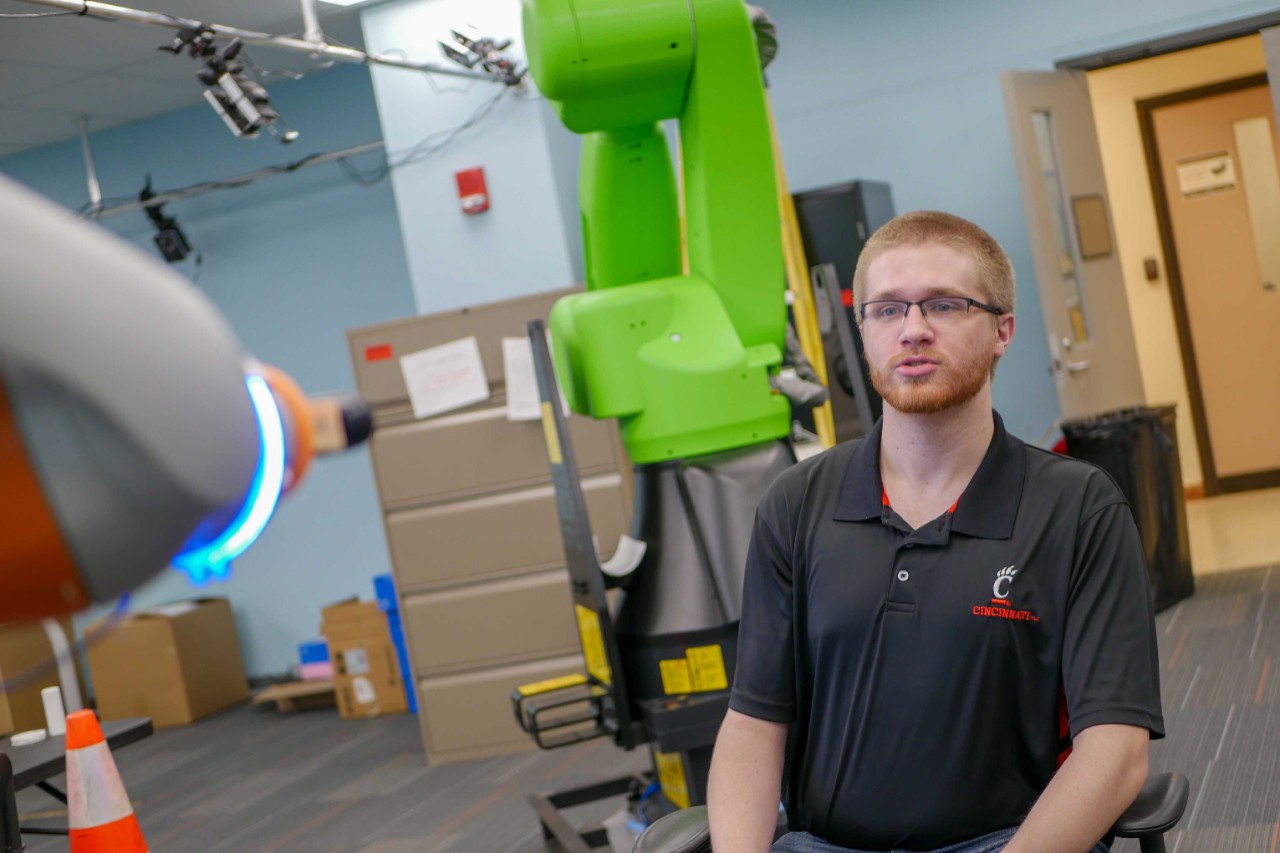
UC student builds face-tracking robot
It’s hard to read faces. It’s even harder if you’re a robot.
Nathan Huber, an electrical engineering technology student at the University of Cincinnati, is developing a robot that tracks facial movements to perform human tasks. His findings can be applied to fields as diverse as manufacturing, healthcare and virtual reality.
“What I’m building here is not a final project, but it’s a step toward something else, something in the future that could change healthcare or industry,” says Huber.
The work advances UC’s innovation agenda, a pillar in the university’s strategic direction, Next Lives Here.

UC student Nathan Huber demonstrates his face-tracking robot. The work, which is part of his capstone project, can be applied to fields as diverse as manufacturing, healthcare and virtual reality. Photo/Corrie Stookey/CEAS Marketing
The robots Huber works with resemble large, squiggly arms holding tiny cameras. Sitting in a rolling office chair across from one of the arms, Huber demonstrates how it works. Huber rolls from left to write, forward and back, and the robot’s camera follows his movements.
Huber programmed these robots to track objects in planes. First, the robot identifies the object and locates it on the X and Y axes. Then, with a spatial-tracking algorithm that Huber wrote, the robots can determine how near or far an object is to grab it.

UC student Nathan Huber explains his work. Huber works under UC professor Ou Ma in Ma’s Intelligent Robotics and Autonomous Systems laboratory. Photo/Corrie Stookey/CEAS Marketing
The computer screen connected to the robot displays the object it’s following: in this case, Huber’s face, which is outlined by a green box.
“What he’s trying to do is get the center of my face,” says Huber. “Within the camera frame, the green box is what the desktop recognizes as a face. I calculate the center of that square, and I have the robot calculate where I'm at in space in respect to the camera.”
The robotic arm mostly moves fluidly, but it does pause every couple seconds, as if it’s processing Huber’s movements.
“There are still some flaws, jitteriness. It’s slow and choppy, but these are things am working through now,” Huber says.
What I’m building here is not a final project, but it’s a step toward something else, something in the future that could change healthcare or industry.
Nathan Huber, UC electrical engineering technology student

A monitor displays the face-tracking robot's field of vision. With a spatial-tracking algorithm that UC student Nathan Huber wrote, the robot can determine how near or far an object is. Photo/Corrie Stookey/CEAS Marketing
Applied commercially, Huber's work can advance virtual reality, like the technologies used in training pilots. Many people training to become pilots train in a virtual reality that simulates a cockpit, says Huber.
A face-tracking robot can hold different parts of a physical cockpit, like a control panel or keyboard. As pilots-in-training look around the virtual interior of a cockpit, the robot can track these facial movements and move a control panel to their lines of sight. When a person reaches out to press a button or pull a switch, a control panel held by one of the robots will be right there.

This robot tracks facial movements to perform human tasks. Photo/Corrie Stookey/CEAS Marketing
In addition to virtual reality, this technology can be applied to healthcare, specifically an aging population. Huber says a robot like this could help his grandmother, who is in a nursing home and has trouble reaching for and holding different things.
“It would be ideal if this robot is sitting next to her, and she looks over at this cup of coffee and the robot’s able to recognize that and able to grab it and bring it to her.”
In May, Huber starts fulltime at Coldwater Machine Company, where he spent all five of his cooperative education (co-op) rotations. Though he worked mostly with static systems at Coldwater, Huber sees a future for dynamic and static interplay. In this scenario, a static robot could repeatedly perform a task, whereas a second dynamic robot would assist with the task.
As for the state of his research at UC: Huber has been writing instructional manuals for all his work, so that students and instructors can pick up where he left off.
“A lot of the robotics passion has come from co-ops that UC offered,” says Huber. “I’m trying to bring back the knowledge that I gained on co-op and leave these manuals so that the future generations have something to learn off of and continue from.”
Note: All of Huber’s projects were built in UC professor Ou Ma’s Intelligent Robotics and Autonomous Systems laboratory.
Featured image at top: UC student Nathan Huber demonstrates his face-tracking robot. Photo/Corrie Stookey/CEAS Marketing

“A lot of the robotics passion has come from co-ops that UC offered,” says UC student Nathan Huber. Photo/Corrie Stookey/CEAS Marketing
Next Lives Here
UC is the region's destination for making, doing, discovery and delivery. Nathan Huber's work advances UC’s innovation agenda, a key pillar in the university’s strategic direction, Next Lives Here.
Related Stories
UC student breaks world record in competitive speedcubing
December 19, 2025
UC computer science student Sujan Feist set a new world record in speedcubing at competition this month in Coshocton, Ohio. Feist is the reigning world champion in the 2x2 division.
Bazinga! UC physicist cracks ‘Big Bang Theory’ problem
December 19, 2025
A physicist at the University of Cincinnati and his colleagues figured out something two of America’s most famous fictional physicists couldn’t: theoretically how to produce subatomic particles called axions in fusion reactors.
Future Tech Forum tackles an AI-driven world
December 19, 2025
Cincinnati innovators and business leaders packed UC’s 1819 Innovation Hub in early December for the Future Tech Forum, where they considered the road ahead for AI.
